Deep in a slum west of the Indian city of Bangalore, a man is unlocking a large metal trunk. Rats scurry nearby, and there is a visceral smell from the rotting rubbish piled up all around.
This fragile, terrible slum constructed of wood and pieces of plastic has been home for a decade to Yallappa, the man with the key to the trunk’s padlock, and 40 others, including children.
Yallappa pushes up the lid of the trunk and puts his hands inside. In a kind of frenzy he starts to toss out the contents: small, bulging plastic bags. One bursts open and exposes loose clumps of human hair. Yallappa starts opening more and more bags, pulling out more and more tangled strands of hair. All of it has been gathered by waste pickers in this slum from the brushes and combs of women in homes within a 5km range.
This is the first link in a chain that leads all the way to high-end hair salons and specialist wig shops in the West; an ever-growing, multibillion-euro industry. The top importers of human hair are the United States, United Kingdom, Japan, France, China and South Korea.
There are 1.3 billion people in India, and these 40 residents of Kadabgere slum are among the poorest of its poor. They are waste pickers, people who collect paper and plastic rubbish from streets and homes, and sell it on for recycling. In a country where so many have so little, things that seem worthless can actually be valuable. Such as human hair.
Entrepreneurship comes in many forms, and although Yallappa lives in what most people in Ireland would consider abject poverty, he is a successful businessman within his community.
It works like this. Other people in this slum, such as Krishna and Shankara (most of the people I talk to go only by their first names), who are sitting beside him, collect hair. They collect only women’s hair. Long black hair has the most value; grey or white hair fetches just a third of the price.
It takes Krishna and Shankara between eight and 10 days to collect a kilo of hair each. Yallappa buys it from them, at 2,400 rupees, or €31, a kilo. He then sells it on for 3,000 rupees, or €38, a kilo. Yallappa himself does not collect hair. He is the entrepreneur who sells on the product.
Patiently, via a translator, the three men explain why collecting hair is considered far superior to collecting plastic or paper.
“They are not picking things up from the street,” Yallappa says.
“Hair is much lighter to carry,” Krishna says.
“You get more money per kilo for hair,” says Shankara.
Yallappa sells the hair on to what the translator describes as an aggregator. The aggregators are always men, and they visit the slums fortnightly or monthly to collect the hair.
At this point the onward trail becomes much more obscure, but the hair continues to change hands. The one certainty is that by the time Indian-sourced hair extensions and wigs end up in the West, their price has soared.
By the time the hair is sold in Dublin it is worth €3,000 a kilo, almost 100 times as much as the hair collectors in Kadabgere get for it
One Dublin hair salon charges €379 for human hair extensions – “full head based on 125 grams”. No country of origin is specified, but it’s evident that the value of the hair continues to depend on weight, no matter how far it has travelled.
By the time the hair is sold in this salon it is worth €3,032 a kilo. Based on the starting price in India of €31 a kilo, that’s almost 100 times as much as the hair collectors in Kadabgere get, right at the start of this chain.
Another Dublin salon quotes its hair extensions as ranging from "€275 up to €1,180". It describes the hair it uses as "the finest handpicked Indian ritual hair" and "great quality Remy Indian temple hair".
If you google “Remy Indian hair”, the definition that comes up is “100 per cent real Indian human hair, chemically unprocessed and intact from the donor”.
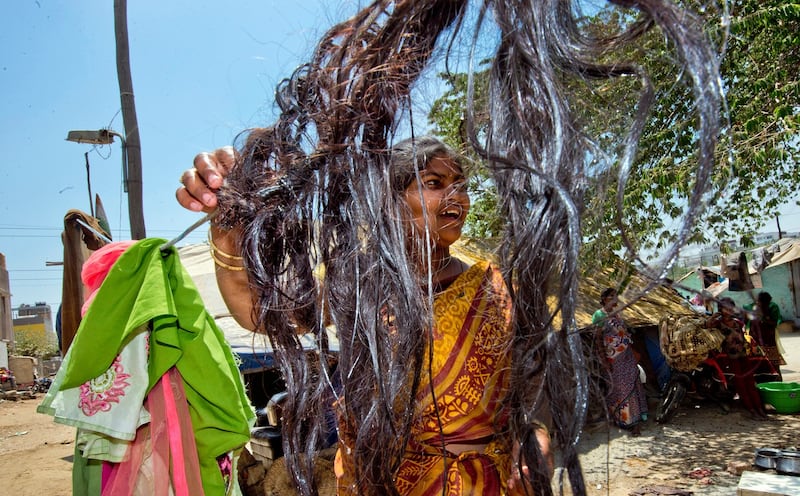
India, with a population of more than a billion, creates plastic and paper waste on an unimaginable scale. The government does what it can to collect it, but such is the scale that much household waste goes straight to landfill, or is burnt.
Many, many small organisations around India try to recycle the country’s waste in a more environmentally friendly way. One of them, Hasiru Dala, is a nonprofit in Bangalore. Its name means Green Force in English, but while its core activity is recycling, what really makes it stand out is its focus on social justice and social inclusion.
Hasiru Dala works with the waste pickers, the poorest and most marginalised people in India. “We try to fill in the gaps that the government doesn’t provide for,” explains Nailini Shekar, who founded the organisation.
It works with 35,000 waste pickers in and around Bangalore, including those in Kadabgere slum who collect hair. Hasiru Dala provides a coveted identity card to each person, a permit that shows they have the right to collect waste.
The cops used to harass waste pickers who went to houses. But they don't do that any more, and they also have respect now from the people in the houses they collect from
The identity card is usually the only piece of formal paperwork these people have ever had. It gives them both dignity and a means of making a living. As Shekar puts it: “When the narration around waste pickers changed, the attitude to them from other people changed too.”
“Respect” is what getting a permit and identity card from Hasiru Dala meant to Sampangi, a picker whom we meet at a dry-waste recycling centre. She shows us a tattered photocopy. The precious original is kept at home. “A rat might do something to it here,” she explains.
The translator elaborates on the value of an official permit and identity card: “The cops used to harass waste pickers who went to houses. But they don’t do that any more, and they also have respect now from the people in the houses they collect from.”
Before Hasiru Dala got involved, these people collected rubbish ad hoc from the streets, and sold it on where they could. Some still do this, but the difference now is that it is bought by one of the 33 designated dry-waste recycling centres established by Hasiru Dala and run by waste pickers themselves.
Others now collect paper and plastic and other domestic dry waste – waste with a guaranteed value – and bring it to the recycling centres to be sorted.
Nailini Shekar estimates that this system now results in 723 tonnes of waste every month being diverted from landfill, in this city alone. So it’s not only that waste pickers now have a steady and guaranteed source of income, plus the respect conferred by an identity card, but also that the environment benefits, too.
The organisations work only with adults, and encourage children to attend school whenever possible. They collect only from homes.
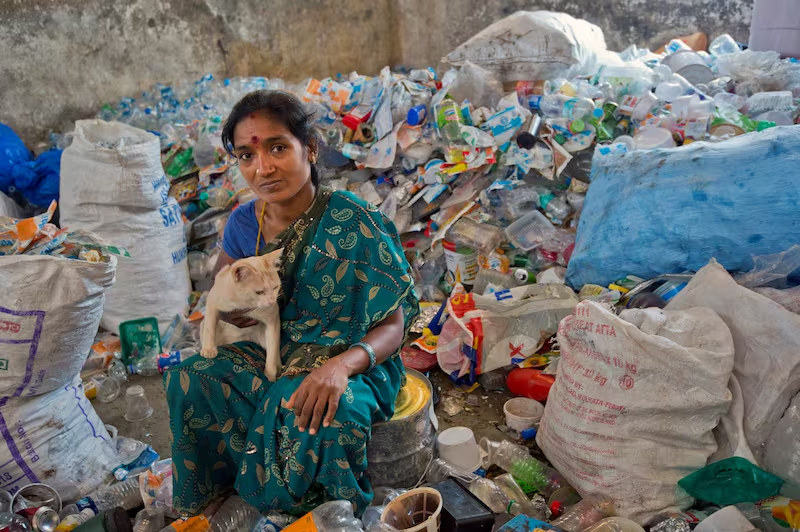
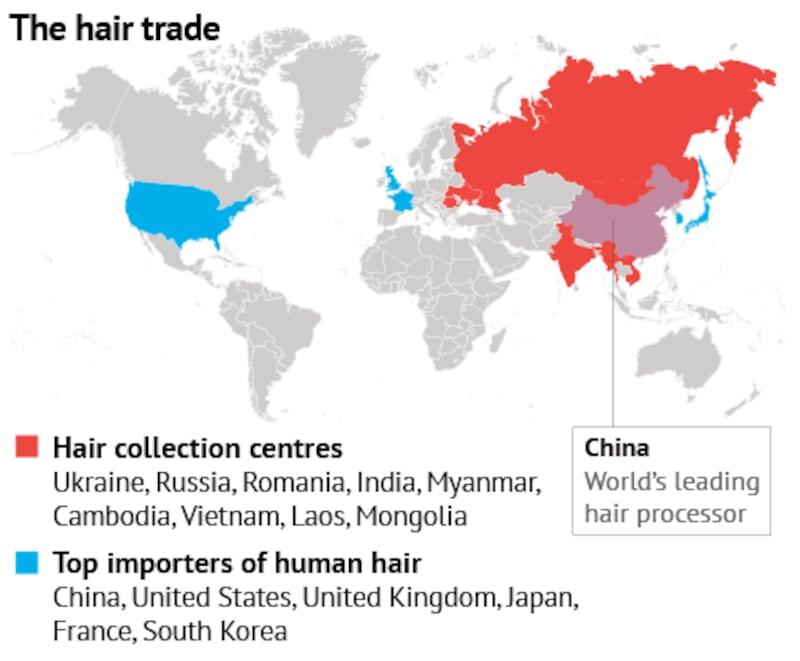
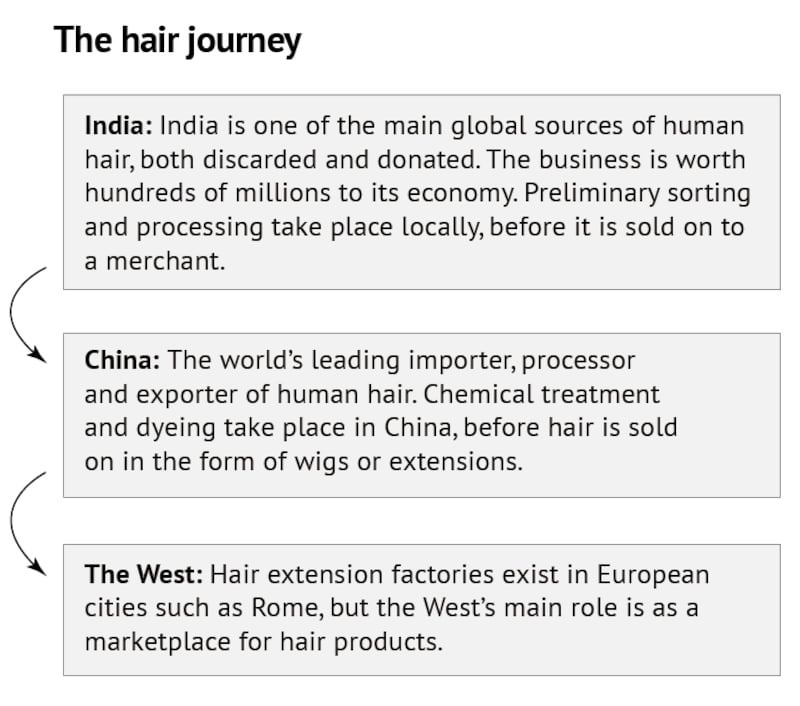
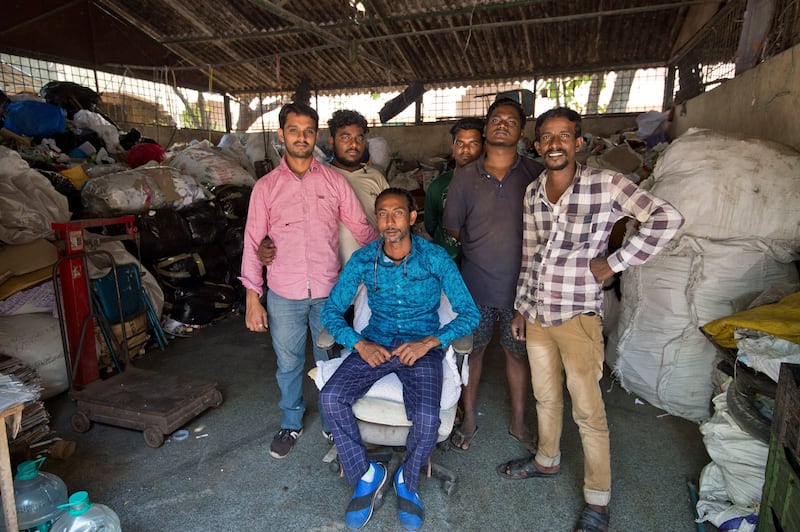
All the waste pickers live in slums. Some of these are long established, created over decades, and built with brick. Others are fragile temporary shacks on wasteland, where land owners can move everyone on overnight. Still others – the absolute poorest slums – are built around mounds of plastic and paper, waiting to be sorted. To a western eye, it looks as if their residents are literally living in a dump.
Common to every slum are the huge bags of rubbish collected by the waste pickers who live there. At Kadabgere slum, dozens of bags of plastic and paper are piled up near the entrance. These bags are weighed and collected frequently by the trucks that bring them to one of Hasiru Dala’s recycling centres.
Plastic water bottles sell for an average of 20 rupees, about 6c, a kilo. Cardboard is six rupees a kilo. Single-use plastic is 10 rupees a kilo.
On one of the five days that we work with Hasiru Dala, we visit the largest of its dry-waste recycling centres. Waste collected from within a 70km radius is deposited here, of the kind picked up from Kadabgere slum.
The city of Bangalore is divided into 198 wards; this is ward 150. The centre looks like acreage of landfill, with six months of collected waste spread all around. It backs on to apartment blocks; there is no such concept as “not in my back yard” here.
The facility at ward 150 is the largest-scale recycling centre we see, and the volume alone makes a powerful visual impact. Without the waste pickers collecting this domestic waste, all of this plastic, paper and dry household goods would have ended up in landfill.
A feral puppy scampers by, tail wagging, large rat in its mouth. That rat is dead, but, judging from the constant shifting and rustling within the mounds of garbage, there are many more live ones nearby
This first thing that hits us is the smell. Although households presort their rubbish into paper and plastic before waste pickers collect it, they don’t wash the food containers. And there are also many other items in different piles, such as empty aerosol cans, detergent bottles, shampoo bottles and cleaning products, all producing fumes.
I had had a different image in my head of what a dry-waste recycling centre would look like. Cleaner. Less visceral. A feral puppy scampers by, tail wagging, large rat in its mouth. That rat is dead, but, judging from the constant shifting and rustling within the mounds of garbage, there are many more live ones nearby.
There are no machines of any kind here. Hasiru Dala does provide the pickers who collect and sort rubbish with gloves and masks, but in the course of a week I don’t see anyone wearing them.
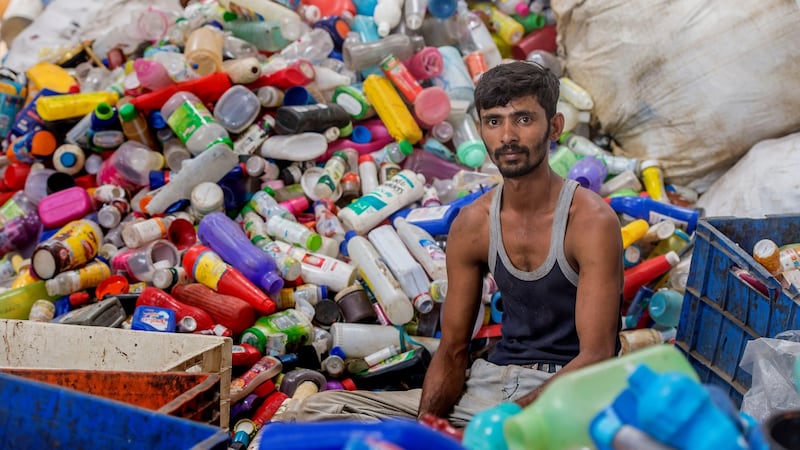
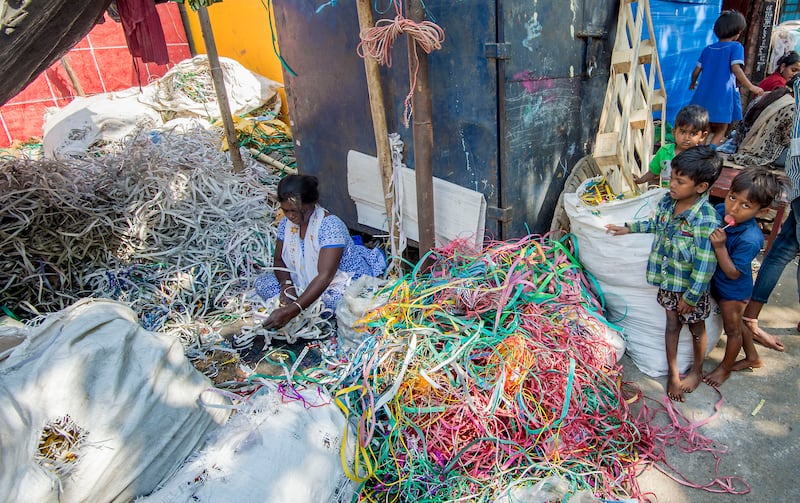
This is how the waste gets sorted. Small trucks periodically enter the site and offload their contents into an open-sided breeze-block structure. Then the waste pickers who work as sorters sit down in the middle of piles of plastic and paper and start the laborious process of dividing and grading it – all of it by hand.
The plastic lids on bottles are of a different weight and substance from the bottles themselves, so they have to removed and put in separate crates. Clear plastic goes in one crate, coloured in another. Aerosol cans have first their lids removed, then the small plastic tops, then the inner stems. That’s four components for one object. It’s painstakingly slow.
The hands of these waste pickers, particularly those dealing with containers that had held cleaning products, are raw with burns. And once the aerosol cans are deconstructed, and lids taken off products such as bleach, fumes rise into the face of whoever is working on them.
About 60 per cent of what arrives on site can be recycled. Certain items, such as furniture, mattresses and shoes, can’t be recycled. Single-use plastic items, such as cutlery, was banned in Bangalore in 2016. However, it continues to be illegally produced, and holds the lowest value.
In the West we consider the strands left on a hairbrush or comb to be worthless. But, in India, most of the women who save this hair for the collectors want something in exchange
Crisp packets, biscuit wrappers and other plastic-foil items can’t be recycled at all. They are burnt, and the ashes used in the cement industry.
The average daily rate for women sorters at these recycling centres is 400 rupees, or about €5. For men it’s more, because, in addition to sorting, men drive the vehicles that bring the rubbish on site, and also offload it. They get 600 rupees, or about €7.50.
It’s a horrible job, but you’d have to collect a lot of plastic water bottles to make the daily equivalent. These jobs as sorters are valuable to those who hold them.
This whole enterprise has the potential to be replicated in other Indian cities and scaled up; to continue to cut down on India’s landfill and provide waste pickers with steady jobs and respect from the wider community.
The waste pickers at Kadabgere slum who collect hair, such as Krishna and Shankara, do not wash or sort it before they sell it to Yallappa. He does not pay anyone to do any further preparation work on it either, and sells it on, unwashed and unsorted, but the process is different in different slums.
Seventy families live in the Bangalore TC Pulaya slum. Of these, 25 collect hair; the others work in construction. Here it’s women who are the hair collectors, carrying on the tradition from their parents, who also did this work. Gangamma is one such woman whose waste-picker parents also collected hair. “There is more money in collecting hair,” another woman, Saljaya, tells us.
Here it takes one person 15 days to collect a kilo of hair. (They also keep their own hair.) Every slum has a different metric of how long it takes to collect this much hair, based on how far people have to walk, the density of the housing, the number of women per household who keep their hair.
The women here – Vishwaramma, Alvelamma, Kavita, Padmavathi, Saljaya and others – go out collecting hair six days a week. Unlike at Kadabgere slum, their work doesn’t stop there. They also sort and wash the hair.
The hair the women in this slum collect does not come free. In the West we consider the strands left on a hairbrush or comb to be worthless, destined only for a dustbin. But in India, most of the women who go to the trouble of saving this hair for when the collectors come around want something in exchange for it.
We follow Vishwaramma, Gangamma, Saljaya, Padmavathi and Tulashi out of Pulaya slum, as they take us through some of the streets they walk on a regular basis.
A woman appears. She has a handful of hair in one palm. One of the collectors examines it, then passes over a small cup in exchange. The cup is worth10 rupees, the equivalent of a few cent
They have their barter items with them. Some are carrying pieces of cardboard with hair clips on them. Others are carrying cheap aluminium vessels; drinking containers, plates and bowls. Some are tiny, others larger: the barter depends on how much hair there is to be collected.
What the women call out as they traverse the streets is, “You have hair? You have hair?” Some of them tap their vessels to make a noise, or rattle the front gates of houses. They have different routes for different days.
A woman appears and opens her gate. She has a handful of hair in one palm. One of the collectors examines it, testing the volume and looking to see whether it’s all black or has some white or grey mixed in. She then passes over a small cup in exchange. I ask the value of the cup; 10 rupees, the equivalent of a few cent.
The women in this slum also receive 3,000 rupees per kilo of black hair from the men who buy it from them. But they have to do a lot more extra work before they receive this money. Collecting the hair takes only a few hours. Far more additional time is spent sorting, washing and plaiting it.
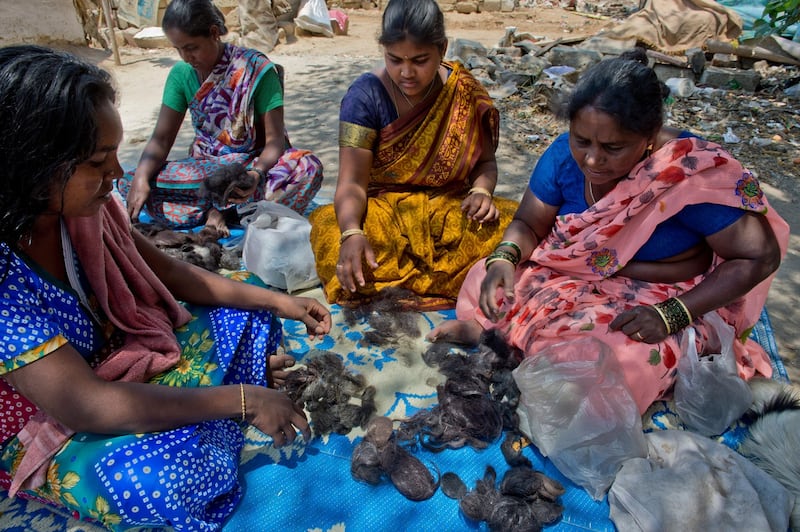
The price of hair
€31 per kilo
Income of hair picker in Bangalore slum
€38 per kilo
Income of hair dealer in Bangalore slum
€379
Price of human hair extensions – "full head based on 125 grams" – in a Dublin salon
€3,032 per kilo
Equivalent price of hair extensions in Dublin, almost 100 times what the hair collectors in India get
<>
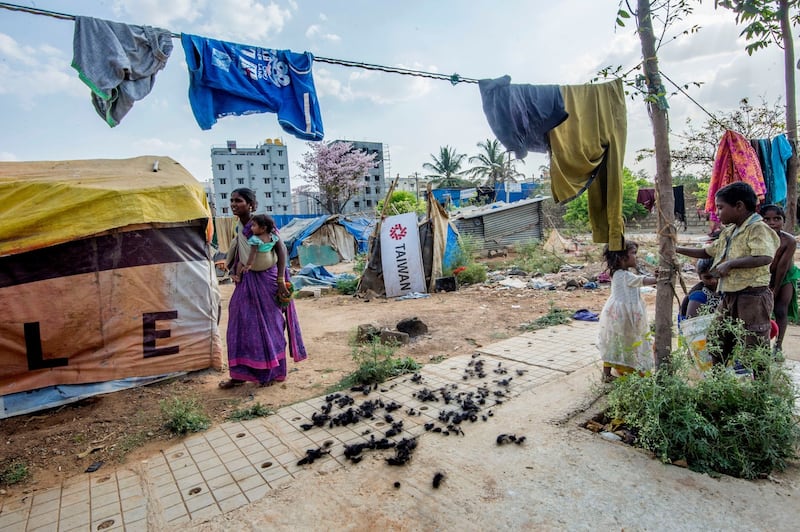
When we return to the slum, some other women are sitting on a mat, sorting grey and white hair from black; working on hair they previously collected. They are picking through the hair strand by strand. For a while we just sit and watch. The women are sitting companionably together, chatting in the hard sunlight, their hands busy.
From a distance they could be women anywhere in the world, working in a craft circle; doing sewing, or knitting or embroidery. But they are not sewing or knitting. They are carefully separating the valuable black hair (3,000 rupees a kilo) from the grey and white (1,000 rupees a kilo). When it’s separated they wrap it around their fingers, as if they were carding wool.
When the hair is sorted it’s organised into hanks, held together by a few rows of tiny plaits at the top. It’s washed after that, if you consider dunking hair in cold water in filthy containers, and then squeezing the water out, to be washing. One woman, Saljaya, hangs wet hanks of long black hair on a line. The effect is surreal.
In this slum the male buyer calls on Sunday to collect the hair. It's the beginning of a journey that the British academic Emma Tarlo examined in her book Entanglement: The Secret Lives of Hair.
Hair extensions last only a few months. Human-hair wigs rarely last more than one year. So the demand for hair generally exceeds supply
Tarlo, a professor of anthropology at Goldsmiths, University of London, travelled the world looking at the culture of hair: the collection, sale and processing of it. In a chapter entitled Harvest, Tarlo writes that hair collection is common in India, Myanmar, Cambodia, Vietnam, Laos and Mongolia.
In Yangon, one merchant who buys hair told her he sells most of it to Chinese manufacturing companies. Another said he sold his stock through the Chinese trading website Alibaba, with his main clients coming from the United States, Germany, Brazil, Turkey and Lebanon. A third told Tarlo he estimated that 500,000 people worked in Myanmar’s waste-hair industry.
All this waste hair is made into extensions and wigs. Hair extensions, whether stuck, stitched or clamped to a customer’s head, last only a few months. Human-hair wigs worn daily rarely last more than one year. Thus, Tarlo writes, “the demand for hair generally exceeds supply, fuelling an almost constant sense of scarcity”.
In October last year, it was reported that the global hair wigs and extension market is estimated to exceed €9 billion by 2023. A large proportion of this hair comes from India, and it is thought most of it now goes to China, to be processed, before being sold on, to salons in the West. Tarlo reports that India's biggest waste-hair exporter is Gupta Enterprises, which claims to have an annual turnover of up to €58 million.
It is hard to be certain about those figures. What is certain, however, is that the hair we are looking at in the TC Pulaya slum in India will eventually end up as hair extensions or in a wig, somewhere in a western hair salon. Perhaps even the one you use.

Rosita Boland and Brenda Fitzsimons travelled to India with the support of the Simon Cumbers Media Fund

















